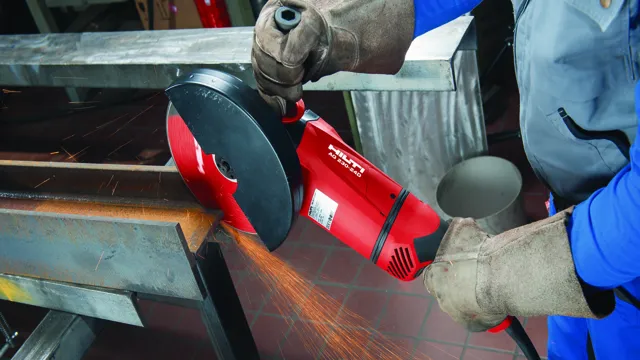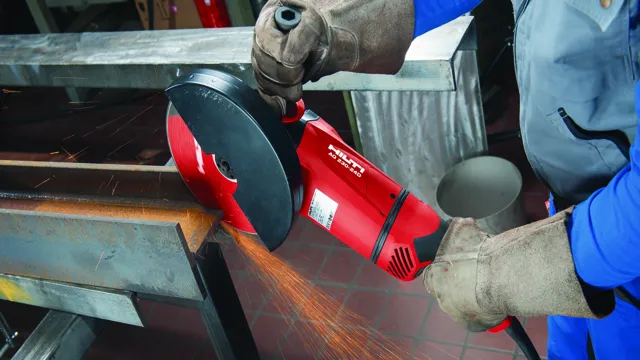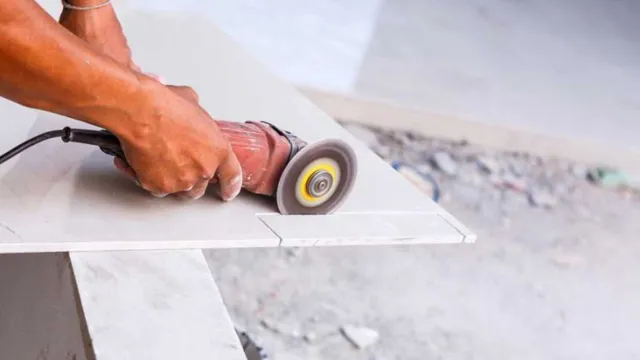What Can an Angle Grinder Cut Through? Tips and Techniques for Optimal Usage

Angle grinders are an incredibly useful tool to have in your arsenal. From grinding and polishing to cutting through hard and stubborn materials, angle grinders are the go-to tool for many professionals. But what can an angle grinder cut through? The answer might surprise you! Whether you’re a DIY enthusiast or a professional tradesperson, an angle grinder opens up a world of possibilities for cutting through an array of materials with ease.
In this blog, we’ll dive deeper into the capabilities of an angle grinder and explore what materials it can cut through effectively. So, grab your safety goggles and let’s get cutting!
Understanding Angle Grinders
An angle grinder is a versatile tool that can be used to cut, grind, and polish a variety of materials. When it comes to what an angle grinder can cut through, the answer is almost anything. From metal to concrete, tile to brick, an angle grinder can typically cut through most materials with ease.
However, it’s important to note that the specific cutting wheel being used will have an impact on what the grinder can cut through. For example, a diamond cutting wheel is best for cutting through concrete, while a metal cutting wheel is ideal for cutting through metal. Additionally, it’s important to use caution and take safety measures when using an angle grinder to ensure a safe and successful project.
Components of an Angle Grinder
Angle grinder Angle grinders are versatile power tools that can cut, grind, and polish a variety of materials. Before buying one, it is important to understand the different components that make up an angle grinder. The motor is the heart of the tool, providing the power to spin the abrasive disc or cutting wheel.
The disc guard covers the disc and helps prevent debris from flying towards the user. The handle provides a comfortable grip and control over the tool, while the trigger is used to start and stop the tool. The disc or cutting wheel is the business end of the tool, and comes in various types, including metal, masonry, and diamond.
When selecting the right angle grinder for your job, consider the disc size, power source (corded or cordless), and safety features like the trigger lock-off. With the right understanding of these components, you can select the right angle grinder for your needs and complete your projects with ease.

Angle Grinder’s Cutting Capacity
Angle grinders are versatile and powerful tools that can make almost any DIY or construction job a breeze. These tools are perfect for cutting and grinding, and their cutting capacity is impressive. They can grind through almost any material, from metal to stone, and even concrete.
The cutting capacity of an angle grinder is determined by the size of the disk that’s attached to it. The larger the disk, the more cutting power you’ll have. However, it’s important to keep in mind that larger disks also produce more noise and vibration, and they can be challenging to handle for beginners.
When choosing an angle grinder, it’s essential to consider the materials you’ll be cutting, the size of the disk you’ll need, and your level of experience. With the right angle grinder, you can achieve precise cuts and smooth finishes on even the toughest surfaces.
Materials Angle Grinders Can Cut
If you’re wondering what materials an angle grinder can cut through, the answer is quite extensive. Angle grinders are incredibly versatile tools that can cut through a variety of materials, such as metal, brick, concrete, stone, tiles, and even wood, depending on the type of blade attached. Metal cutting blades, for example, can be used to cut through different types of metal, including steel, aluminum, and iron, making them ideal for projects such as automotive repairs or cutting metal pipes.
Concrete cutting blades, on the other hand, are perfect for cutting through bricks, tiles, and stone, and they’re often used in construction or remodeling projects. It’s worth noting, however, that different blades are specifically designed for different materials, and using the wrong one can cause damage or accidents. So, always make sure to select the appropriate blade for the material you’re working with and wear the necessary safety gear.
Metal Cutting with an Angle Grinder
Angle grinders are a versatile tool that can be used for many different applications, including metal cutting. As long as you have the right grinding disc, an angle grinder can cut through a variety of materials, such as steel, aluminum, and even concrete. However, it’s important to use the correct type of disc for the material you’re cutting.
For example, a rough grinding disc is best for cutting through thick metal, while a fine disc is better for thinner sheets of metal. Another consideration is the RPM rating of your grinder, as higher RPMs are needed for tougher materials. With a little bit of knowledge and practice, an angle grinder can be a great tool for cutting metal with precision and ease.
Concrete Cutting with an Angle Grinder
As a versatile tool, an angle grinder can cut through a wide range of materials, and concrete is no exception. With the right blade and technique, angle grinders can make quick work of even the toughest concrete surfaces. Whether you need to make precise cuts to create openings for plumbing or electrical work or simply want to smooth out rough edges, an angle grinder is up to the task.
Concrete cutting discs are made of abrasive materials like diamond or silicone carbide, which are specifically designed to withstand the hardness of concrete. Additionally, an angle grinder can be used to cut through brick, asphalt, and other materials commonly used in construction projects. It’s important to choose the right blade for the job and take proper precautions to protect yourself and others from injury.
By following proper safety procedures and using the appropriate equipment, you can achieve professional results with an angle grinder.
Brick and Mortar Cutting with an Angle Grinder
Angle grinders are powerful tools that can cut through various materials, including brick and mortar. They are a popular choice among professionals and DIY enthusiasts because they are versatile and efficient. When it comes to brick and mortar cutting, angle grinders can handle these materials with ease, provided they have the right blade.
Diamond blades are the most suitable choice as they are durable and can withstand the harshness of cutting through hard materials. Angle grinders can cut through these materials quickly and precisely, making them ideal for jobs that require a lot of cutting. Whether you’re cutting through bricks for a home renovation project or cutting through a concrete wall, an angle grinder is a reliable tool that can get the job done.
So, if you’re looking for a tool that can handle brick and mortar cutting, an angle grinder equipped with a diamond blade is your best bet.
Safety Precautions While Using Angle Grinders
Angle grinders are versatile tools used for cutting, grinding, and polishing various materials such as metal, masonry, and wood. They can cut through different thicknesses of materials using a variety of attachments. Angle grinders can cut through metal pipes, rods, and bars easily, making them a preferred tool among welders and metal fabricators.
With the right attachments, they can also be used to cut through concrete, bricks, and tiles. However, safety precautions must be taken when using angle grinders. One of the essential safety precautions is to wear proper protective clothing, including eye and ear protection, gloves, and a face mask.
It’s also important to check the attachments before use, grip the tool firmly, and keep it away from the body. Moreover, angle grinders pose a risk of kickback, so make sure to keep a firm grip on the tool, especially when cutting through tough materials. Overall, angle grinders are very versatile tools that can cut through various materials quickly and easily, but they must be handled with care and caution.
Wear Proper Gear
When using angle grinders, one of the most important safety precautions to remember is to wear proper gear. This includes eye protection, earplugs or earmuffs, gloves, and a sturdy pair of work boots. Flying debris, sparks, and loud noise are just a few of the hazards that can cause serious injury if you are not properly protected.
Eye protection is especially important since angle grinders can produce high-speed projectiles. You should also wear gloves to prevent burns or cuts from the sharp edges of the grinder discs. Furthermore, sturdy work boots that cover the ankles and have slip-resistant soles can protect your feet from falling objects and dangerous slips and trips.
So, always make sure you are dressed appropriately before starting work with angle grinders. Your safety is crucial and you don’t want to take any chances with it.
Secure the Workpiece
When using angle grinders, one crucial safety precaution is to secure the workpiece. This means making sure that the piece you are cutting or grinding is held firmly in place and cannot move around, which can cause the grinder to catch or kick back. There are various ways to secure a workpiece, such as clamps or vices, depending on the size and shape of the piece.
It’s also important to choose the right type of grinding wheel or cutting disc for the material you are working on, as using the wrong one can cause the wheel to break or the disc to shatter. By taking these safety precautions and being mindful of your surroundings, you can avoid accidents and injuries when using an angle grinder.
Conclusion
In summary, an angle grinder can cut through almost anything it sets its sharp, spinning blades on. From metal to tiles, from wood to concrete, it can be a true workhorse in the right hands. However, it’s important to always prioritize safety first and wear the proper protective equipment when operating this powerful tool.
So go ahead, put that angle grinder to the test and see what it can slice and dice – just make sure you’re using it wisely!”
FAQs
What is an angle grinder?
An angle grinder is a power tool that is used for grinding, cutting, and polishing.
What types of materials can an angle grinder cut through?
An angle grinder can cut through various materials such as metal, tile, concrete, brick, and stone.
What is the best blade to use for cutting metal with an angle grinder?
The best blade to use for cutting metal with an angle grinder is a diamond-tipped or abrasive blade.
Can an angle grinder be used for cutting wood?
Yes, an angle grinder can be used for cutting wood with the right attachment such as a chainsaw blade or specialized cutting disc.
Is an angle grinder safe to use?
While an angle grinder is a powerful tool, it can be safe to use when practiced with caution and proper safety gear such as gloves and goggles.
How often should I replace the blade on my angle grinder?
The blade on an angle grinder should be replaced when it becomes dull or worn, or after approximately 10 to 15 hours of use.
Can an angle grinder be used for polishing?
Yes, an angle grinder can be used for polishing with the right attachment such as a polishing pad or disc.



